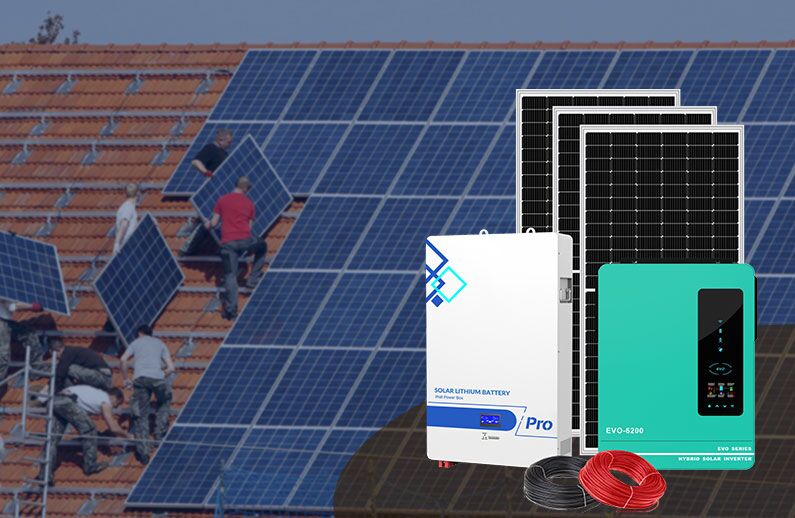Apakah lebih baik memiliki satu baterai surya besar atau beberapa unit yang lebih kecil untuk cadangan seluruh rumah?
Apr 03, 2025
Saat mendesain Baterai cadangan tenaga surya untuk seluruh rumah sistem, pemilik rumah sering kali menghadapi keputusan penting: haruskah mereka memasang satu baterai besar atau beberapa unit yang lebih kecil? Setiap pendekatan memiliki keunggulan tersendiri tergantung pada kebutuhan energi, anggaran, dan skalabilitas di masa mendatang. Analisis ini mengkaji kedua konfigurasi untuk membantu Anda menentukan solusi terbaik untuk penyimpanan energi surya modular yang andal.
1. Baterai Tunggal Besar: Kesederhanaan dan Efisiensi Biaya
Baterai berkapasitas tinggi tunggal (misalnya, 15–20 kWh) sering dipilih karena pemasangannya yang mudah dan biaya awal per kWh yang lebih rendah. Pilihan ini cocok untuk rumah dengan:
Permintaan energi yang dapat diprediksi: Ideal untuk memberi daya pada sirkuit penting (kulkas, lampu, HVAC) selama pemadaman listrik singkat.
Keterbatasan ruang: Hanya membutuhkan satu titik pemasangan dan sambungan kabel yang lebih sedikit.
Perawatan lebih rendah: Pemantauan unit tunggal menyederhanakan manajemen sistem.
Namun, keterbatasannya meliputi:
Tidak ada redundansi: Jika baterai rusak, seluruh sistem akan mati.
Skalabilitas terbatas: Perluasan kapasitas mungkin memerlukan penggantian seluruh unit.
Bagi pemilik rumah yang mengutamakan kesederhanaan, satu baterai menyediakan solusi hemat biaya solusi daya off-grid yang dapat diskalakan untuk kebutuhan pencadangan dasar.
2. Beberapa Baterai yang Lebih Kecil: Fleksibilitas dan Redundansi
Sistem modular (misalnya, tiga baterai 5kWh) menawarkan keuntungan untuk rumah tangga yang lebih besar atau lebih dinamis:
Perluasan bertahap: Tambahkan unit seiring bertambahnya kebutuhan energi (misalnya, pengisian daya kendaraan listrik, pompa kolam renang).
Redundansi: Jika satu baterai rusak, baterai lain tetap menyediakan daya.
Manajemen beban: Mendistribusikan daya yang digunakan untuk memperpanjang umur baterai.
Pendekatan ini lebih baik untuk:
Rumah berenergi tinggi: Dengan beberapa peralatan berdaya tinggi (misalnya, pompa sumur, AC).
Sistem di luar jaringan: Di mana keandalan sangat penting dan pemadaman dapat berlangsung berhari-hari.
Persiapan untuk masa depan: Mudah beradaptasi dengan teknologi baru seperti integrasi kendaraan ke jaringan (V2G).
Kompromi yang ada meliputi:
Biaya awal lebih tinggi: Lebih banyak komponen (inverter, kabel) meningkatkan kerumitan instalasi.
Persyaratan ruang: Beberapa unit mungkin memerlukan area penyimpanan khusus.
Bagi mereka yang mencari kemampuan beradaptasi penyimpanan energi surya modular, unit-unit kecil yang saling terhubung memberikan fleksibilitas jangka panjang.
3. Faktor Keputusan Utama
Untuk memilih antara konfigurasi, evaluasi:
Penggunaan energi harian: Hitung total konsumsi kWh selama pemadaman listrik (misalnya, 30 kWh/hari untuk cadangan seluruh rumah).
Beban kritis: Prioritaskan sirkuit yang harus tetap online (perangkat medis, sistem keamanan).
Anggaran: Bandingkan biaya per kWh untuk sistem tunggal vs. modular, termasuk pemasangan.
Kebutuhan masa depan: Rencanakan penambahan seperti panel surya atau pengisi daya kendaraan listrik.
Pendekatan hibrida—menggabungkan satu baterai besar dengan tambahan modular—dapat menyeimbangkan keandalan dan skalabilitas untuk solusi daya di luar jaringan yang dapat diskalakan.
Untuk cadangan baterai surya di seluruh rumah, baterai tunggal yang besar cocok untuk pengaturan yang lebih sederhana dan hemat anggaran, sementara sistem modular unggul dalam redundansi dan ekspansi. Nilai profil energi rumah tangga Anda dan konsultasikan dengan pemasang bersertifikat untuk merancang sistem yang optimal.


 DIDUKUNG JARINGAN
DIDUKUNG JARINGAN